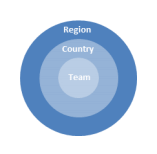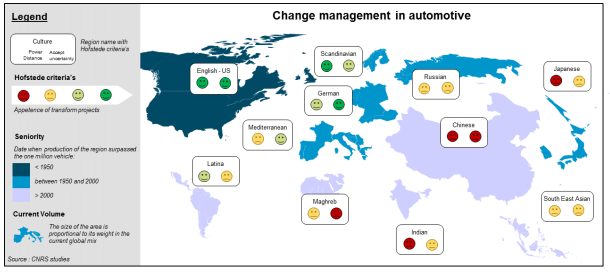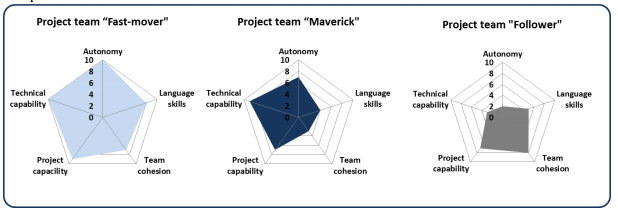Points of view | Insights
INTERNATIONAL PROJECT ROLL-OUT: CONDUCT A TRANSFORMATION PROJECT IN SUBSIDIARIES AROUND THE WORLDFor a multinational company, align its subsidiaries on common standards and performance levels is a complex exercise which is part of large-scale transformation projects. With two major trends are emerging.
- Change accelerates
Multiplication of projects within the company to finish in a reduced time. - Change becomes international
Globalisation imposes to realize these projects within multicultural entities.These trends raise 2 questions:
How international transformation projects are different from other projects involving a single entity?
How to bring to a successful conclusion the change management in subsidiaries abroad?
We can identify three structural levels:
|
 |
Region level – Consider cultural aspects
To conduct global transformation projects, cultural differences should be taken into account. According to Hofstede’s work, two criteria are dominant:
- Power distance
Autonomy, ability to progress, respect for authority. - Acceptance of uncertainty
Flexibility, ability to get out of his comfort zone.
Two additional factors also influence the adhesion capacity of transformation projects within the company:
- The industrial age in the region
In a region with an old industrial culture, know-how is important and processes are deeply understood by stakeholders. Conversely, in emerging region, know-how is less important but less polluted by prejudices. - Industrial activity in the region
When the activity of the region where the subsidiary is located is important, the project will be prioritized and thus mobilization and allocation of local resources will be facilitated.
These cultural appearances to be taken into account during a transformation project can be mapped so in the following way for the automotive sector:

Country level – Examine the structure of the subsidiary
Each subsidiary will react differently to the step of change that appears. Different structural parameters must be considered for each of the subsidiaries in which the transformation project will be implemented:
- Capital structure
Loyalty and belonging feelings are as important as the share of the subsidiary capital owned by the headquarter. Acceptance and commitment of the subsidiary for the project will be stronger. - The age of the subsidiary
Please note this factor is not necessarily similar to the age of the industrial sector of the region. Change will be even easier to implement than the subsidiary’s young. - Corporate culture
Ability to change also depends on the company culture, working methods and style of governance. - Geographical distance
Working hours differences make collaboration less reactive and physical meetings most complex and costly.
The structure of subsidiaries will impact the approach to take for the project implementation
Team level – Appreciate local personal skills
At the last level, it is similar to the classical transformation projects: it is essential to understand local teams’ capabilities, strengths and weaknesses.
- Language skills
Ease of dialogue and communication between headquarter and subsidiaries are often underestimated. Common language level between the project team of the subsidiary and that of the headquarter must be taken into account. - Technical capabilities
Technical capacities are not necessarily the same from one country to another. It is essential to understand quickly the expertise of the subsidiaries project team members. It allows to work in more autonomous way for the local teams during the project execution. - Project minded team members
Transformation projects are managed and controlled through different methods – milestones, planning, recovery problems – to be shared. It is important to understand the project terms and priorities for all members. - Team cohesion
Many transformation projects make work together various departments of the subsidiary. Their level of understanding as their geographic distance depends on the country. - Autonomy
Personality and skills but also the management style of the hierarchy or the capitalization of knowledge are to be taken into account to identify the degree of autonomy of each subsidiary.
All these criteria are used to characterize and better understand each project team. Some typical examples:

Conclusion
Difficulties of international transformation projects come from:
- The subsidiary, a lack of knowledge of the company’s standards or a lack of knowledge capitalization.
- The central, an excessive wish to standardize but especially to an underestimation of the differences between subsidiaries and local specificities.
Key success factors of an international transformation project are :
- Involve the hierarchy
It is necessary to rely on strong sponsors, both within the parent company in the subsidiaries to support the management of change by highlighting the changing needs and objectives. These sponsors should be involved in the project from its introduction and sustainable manner not only in case of problems. A break between the headquarters and the subsidiaries is the most significant risk in this
type of project. - Have an overview
Cultural risks and the local stresses are anticipated from the start of the project in the contextual analysis. This allows better control or avoid problems in the deployment phase impacts will be even less penalizing. - Identify key population
During the preparatory meetings, the behavior of the different actors will measure the degree of support the project of transformation. Each member of the project team will be more or less proactive. Success of the project requires the consent of all. The way to lead would be different depending on the speaker, as it is to rely on fast-mover actors, convince undecided and limit the power of nuisance from refractory people. - Adapt the project
Organizational problems, maladaptive processes and existing tensions between different services, are to be considered as the project of improvement opportunities. It is necessary to accept this compromise and seek consensus.
Pagamon is a strategy and transformation consulting firm founded in 2013. We support major players in the industry, services and life sciences sectors in their search for balance. Helping them structure their strategic vision, transform their operational and/or digital model, and drive change. To support profitable, sustainable and responsible growth. As a committed player, Pagamon leads the Observatory of the Balanced Organization™, articulated around a “think tank” and an annual survey. In order to provide an innovative, sometimes offbeat, perspective on the strategic support of transformations to support the growth of companies.
